Bear (gay culture)
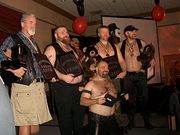
Bear is LGBT slang for those in the bear communities, a subculture in the gay/bisexual male communities and an emerging subset of LGBT communities with events, codes and culture-specific identity. It also describes a physical type.
Bears tend to have hairy bodies and facial hair; some are heavy-set; some project an image of working-class masculinity in their grooming and appearance, though none of these are requirements or unique indicators. Some bears place importance on presenting a hypermasculine image and may shun interaction with, and even disdain, men who exhibit effeminacy.[1] The bear concept can function as an identity, an affiliation, and an ideal to live up to, and there is ongoing debate in bear communities about what constitutes a bear, however a consensus exists that inclusion is an important part of the Bear Community.[2][3]
Bears are almost always gay or bisexual men, although increasingly transgender men (transmen) and those who shun labels for gender and sexuality are also included within bear communities.
Contents |
Origins
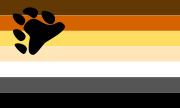
The International Bear Brotherhood flag designed in 1995 by Craig Byrnes (VA Copyright 760–763), digital graphic by Paul Witzkoske for Bear Manufacturing[4]
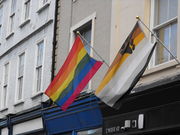
The International Bear Brotherhood flag flown beside the Rainbow Flag
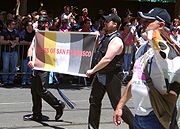
A bear group marching in San Francisco Pride in 2004
|
Bear in LGBT communities is a metaphorical reference to the animal of the same name with similar notable features. These features include the animal's hairiness, its solid proportions, and its physical power. The bear is both fat and powerful, and the reconciliation of these two qualities is at the heart of the Bear concept's appeal. Bears are typically very similar in appearance to the ideal of the North American lumberjack. A romantic conflation of the bear and the lumberjack image provides the Bear trope its metaphorical appeal.
Lumberjacks were romanticized and fetishised in gay culture long before the arrival of the Bear concept, and the Bear concept retains strong traces of this older ideal. Lumberjacks appealed to gay men at aesthetic levels but also for the fact that they were working class, and for the fact that their isolation from urban society (and hence from mainstream gay culture) opened up a fantasy of both secrecy and liberation, within an idyllic, rural, North American setting. These metaphors also lend themselves to the idealization of natural physical appearance and preferences over more glamorized ones despite the convenience many bears may find living in urban settings.
The self-identification of gay men as Bears originated in San Francisco in the 1980s as an outgrowth of gay biker clubs like the Rainbow Motorcycle Club, and then later the leather and "girth and mirth" communities. It was created by men who felt that mainstream gay culture was unwelcoming to men who did not fit a particular "twink" body norm (hairless and young). Also, many gay men in rural America never identified with the stereotypical urban gay lifestyle, and went searching for an alternative that more closely resembled the idealized blue collar American male image.
Early pioneers
- Bear Magazine
Richard Bulger, publisher, and his partner, Chris Nelson, started Bear Magazine—originally a photocopied flyer—from their apartment in San Francisco in 1987. Over a 5-year period, the magazine grew to an internationally distributed high-gloss format, but still intentionally kept the stark look of Chris' black and white photography. Their company, Brush Creek Media Inc., obtained a trademark on the name "Bear" for a men's magazine in 1992.[5] Bearded, blue-collar, rural, and working-class men were idolized in the magazine.
- Lone Star Saloon
Richard's friend Rick Redewill, who had founded San Francisco's "Lone Star Saloon"[1] in 1989, bought full-page ads in every issue of Bear; they soon found themselves with a huge success nationally, especially among rural gay Americans, who would travel to San Francisco just to find a unique "blue collar" gay bar, filled with a masculine-identified crowd who were radically different from the stereotypical gay bar image. The Lone Star became "ground zero" for the incubation of the Bear Community between 1990 and 1993. Unlike other gay clubs where dance music was the norm, the Lone Star played rock music for the appreciation of a more masculine-identifying customer base. Much of the Lone Star staff, including its owner, Redewill, were overwhelmed by the AIDS pandemic that enveloped San Francisco's LGBT communities. The bar was turned over to new owners in 1993.
Online
The Bear subculture preceded mainstream usage of the Internet and online social networking. Gay men who felt they were not welcome at their local gay meeting places or had no place found easy access to and acceptance from similar people online. Gay men became early adopters of the online Bear communities. Bear codes were developed in the late 1980s and early 1990s and were used in email and on Usenet boards.
The Natural Bears Classification System or "Bear codes" are sometimes used in e-mail (often as part of a signature block), web postings, and online profiles to identify Bear-related attributes of the author or poster. See, e.g., "The Bear Codes" on the Resources for Bears Web site. A sample Bear code is:
- B4 s- m g++ w d+c t+ f+ k+ r e+(+?)
Bear Code may be the earliest example (1989) of Internet self-classification codes. Familiarity with this classification system is concentrated in the sub-community of Bears who were early adopters of Internet communications, and is not widespread within the general community.
Events and activities
At the onset of the Bear movement, some Bears separated from the gay community at large, forming "bear clubs" to create social and sexual opportunities for their own. Many clubs are loosely organized social groups; others are modeled on leather biker-patch clubs, with a strict set of bylaws, membership requirements, and charities. Bear clubs often sponsor large yearly events—"Bear runs" or "Bear gatherings" like the annual events such as International Bear Rendezvous, Bear Pride, TBRU, BearBust, drawing regional, national and international visitors. Many LGBT events attract a significant bear following, such as Southern Decadence [2] in New Orleans. A feature at many Bear events is a "Bear contest," a sort of masculine beauty pageant awarding titles and sashes (often made of leather) to winners.
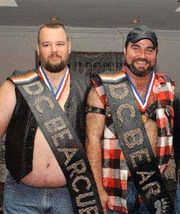
One example of a bear contest is International Mr. Bear, held each February at the International Bear Rendezvous in San Francisco. It attracts contestants, often with local titles, from all over the world. The first International Mr. Bear was held in 1992. The contest includes Bear, Daddy, Cub, and Grizzly titles with the contestant who receives the highest score winning the bear title, regardless of what type he is. Example: "Mr. Washington, D.C. Bear, 2006."
Gay "leather-bears" have competed in leather contests, and "muscle-bears" are another subculture noted by their muscular, often very large muscle body mass.
The Bear community has spread all over the world, with Bear clubs in many countries. Bear clubs often serve as social and sexual networks for older, hairier, sometimes heavier gay and bisexual men, and members often contribute to their local gay communities through fund-raising and other functions. Bear events are common in heavily-gay communities.
The gay Bear community constitutes a specialty niche in the commercial market. It offers T-shirts and other accessories as well as calendars and porn movies and magazines featuring Bear icons, e.g., Jack Radcliffe. Catalina Video has a bear-themed line: the "Furry Features Series." Other adult studios who feature Bear-type men are Bear Magazine, 100% BEEF Magazine, BearFilms, Bear, Butch Bear, Raging Stallion, and Titan Media.
As more gay men have identified themselves as Bears, more bars, especially leather or western bars, have become Bear-friendly. Some bars cater specifically to Bear patrons. As Bears have become more common in the larger gay culture, and as more gay and bisexual men identify themselves as Bears, Bears have not segregated themselves as much as they once did. Gay Bears are now a mainstream element of the gay community at large because of the community.
Characteristics
As the Bear Culture has matured, it has subdivided itself, and many claim that discrimination has increased within the Bear community as some men who self-identify as "Bears" or "Musclebears" do not welcome higher-bodyfat men (see Chub) at their events. A common criticism of the Bear community is that some self-described Bears tend to exclude men who do not fit their standards of what a "real Bear" is. Fat (or lack of it) is a political issue among Bears, some of whom see their overweight condition as a form of self-acceptance. Some also note a lack of racial diversity in the Bear community, perceiving hirsuteness to be a standard of physical attractiveness that genetically favors white men aesthetically, socially, and sexually among Bears.[1] However what appears as racial discrimination to some may be a result of the fact that in the Bear context in which hairiness is prized, Native Americans, African peoples, East Asians, and Pacific Islanders, among others, tend to have less facial and body hair than men of Caucasian descent.[1]
The AIDS devastation in San Francisco accelerated the generation gap between older and younger Bear-identified men, peaking in the early 1990s, with few connections that survived between the two. Some older survivors claim that the current Bear culture has become "shallow and catty," which is also their common criticism of mainstream gay culture. The allegation is that the younger Bear community no longer reflects the culture's original function as a social alternative for primarily rural and blue-collar, traditionally masculine gay men. Moreover, the proliferation of Bear pageants and their title winners ("sash bears") runs contrary to the early Bear community's identification with and admiration for raw, unself-conscious masculinity.
References in pop culture
Though not generally widely known outside of the gay community, the "Bear" concept has surfaced in pop culture.
Live events
- On September 1, 2007, in a live interview called "The TrekTrak Show" with Star Trek: The Next Generation actors Jonathan Frakes (Riker), Brent Spiner (Data) and Gates McFadden (Dr. Crusher) at Dragon*Con, host Eric L. Watts (who self-identifies as a Bear) asked Frakes if he was aware that he was "something of an icon in the Bear community."[6]
Television
- In 2008, Logo aired Bear Run, a documentary about the bear community.
- On the Bravo reality show My Life On The D-List in 2008, star Kathy Griffin took Apple co-founder Steve Wozniak to a "Bear Convention" referring to him as a 'Billionaire Bear'.
- Showtime's Nurse Jackie has a recurring character, Thor, who is described as a bear and played by Stephen Wallem. It was revealed in the beginning of the 2010 season that Thor has lost an eye due to diabetes, but still persists in unhealthy overeating.
- The short-lived television sitcom Normal, Ohio starred John Goodman as a bearish gay man.
- In the British sitcom Absolutely Fabulous Edinas ex-husband Marshall is set-up with a gay bear by his wife Bo to "test" whether he is a homosexual.
- On the September 25, 2007 episode of The Late Show with David Letterman, director Kevin Smith revealed that he will be on the cover of the next issue of A Bear's Life magazine, and gives the audience a quick introduction to Bears in general.
- On the July 25, 2007 episode of Top Chef, the host reads a question from a viewer directed towards Tom Colicchio asking, "Do you realize that you are an icon of the Bear community?"
- On the American cartoon Family Guy, a television show that Peter is watching called The Life and Times of Grizzly Adams portrays Grizzly Adams and his bear pal "Ben" as a feuding gay couple. Ben has a high voice and is washing dishes, a clear allusion to gay bears, as Ben is a very large grizzly bear in the real series and the cartoon.
- On the American television show Queer Eye for the Straight Guy, a stocky and hairy man receiving a makeover was informed by one of the hosts that, "In our community, you would be called a Cub!"
- The Kids in the Hall Season 5 episode 2 1994, a skit called "Grizzly" showed Kevin McDonald being "attacked by a bear" in a gay bar and surviving by flashing back to his Boy Scout training, eventually "playing dead."[7]
- In The L Word, season three's episode 2 ("Lost Weekend"), characters Jenny and Moira enter a club's "Bear Night" and dance among large, bearded men.
- On the reality show Can't Get a Date, singer/actor James Bradford identifies as a Bear (but is shown actively trying to lose weight)
- On the June 19, 2006 episode of The Colbert Report, Stephen Colbert listed Bears as the top threat to his continued heterosexuality, a play on his previously stated fear of the animal of the same name.
- On the 11 August 2006 episode of Big Brother's Big Mouth, Russell Brand spoke to a member of the studio audience and asked them "You're what is known in the gay community as a Bear, aren't you?"
- On an episode of The Simpsons, Homer Simpson leaves his wife and while looking for a place to live, ends up apartment searching in Springfield's gay village. While standing with the closeted Waylon Smithers, a group of Smithers' friends drive by with one of them yelling "Hey Waylon! Who's the Bear? Woof!" (referring to Simpson.)
- In another episode of The Simpsons in which a Brown Bear wanders into Springfield, Homer stirs up the government to provide a "bear patrol" to rid the town of bears. On their protest march to the town hall Homer chants "We're here, we're queer, we don't want anymore bears" when Lenny asks if Homer came up with it Homer claims "Oh, I heard it at the mustache parade they have every year."
- In the animated TV series Freak Show, one of Freak Squad's members is Log Cabin Republican, a thin, effeminate homosexual whose superhuman ability is to turn into the "Burly Bear," a taller, more muscular man dressed in biker gear.
- On an episode of Late Night with Conan O'Brien, the actor David Duchovny claimed that his daughter nearly stumbled upon a web site dedicated to gay Bears, while researching a project on the animals. He then went on to awkwardly describe the Bear community, as well as claiming that O'Brien's former sidekick Andy Richter was considered a "cub" by members of the community.
- In an episode of It's Always Sunny in Philadelphia entitled "The Gang Sells Out," the gang, in trying to sell their bar to a representative of a national chain, discusses at length the differences between bears and twinks, when the representative informs the gang that he is gay.
- "Round Table" regular Guy Branum of the late night talk show Chelsea Lately has made many references to his homosexuality, including mentioning that he's a bear at least once.
- In the episode "American Dream Factory" of American Dad!, Stan Smith makes reference saying 'Did you know that in the gay community a hairy man is also known as a bear?'
- In the episode "Once Upon a Tyne in New York of The Cleveland Show, Tim (who is an actual bear) is on the phone with his wife when he stumbled across a bar. "There a bar here with a sign that says 'Bears Welcome'," he says, and the focus pulls back to reveal a gay bar called "The Nut Bush". As the door closes behind him, two bears with their hands in each others' back pockets walk in behind him. He later calls Cleveland for help, and is shown inside dancing provocatively with a number of undressed gay bears.
Music
- Bearapalooza is a touring group of musicians identified as Bears, that was founded by musician Freddy Freeman in New York City in 2002. The event is co-produced by Nashville singer/songwriter Michael West.
- Bears On The Run is a tour of four solo Bear musician artists featuring Elijah Black, Matthew Temple, Shannon Grady and Kendall, and hosted by comedian Bobaloo. The tour has travelled to twenty major US cities.
- Bear Radio Network is a 24/7 radio webcast based in Rochester, New York for the Bear Community. The program features a mix of bear-identified indie artists.
- The BEARatones are a Seattle based Bear singing group who sing about the Bear community.
- Bearforce1 is a Bear pop-group in the Netherlands.
- The song "Oh Word?" by The Beastie Boys contain the lyrics "I swear it wasn't me in Bear magazine / Because I'm not that hairy oh contrary".
- The song "Walcott" by Vampire Weekend contains the lyric "Fuck the bears out in Provincetown," a reference to the gay community in the Cape Cod city of Provincetown.
- Singer Troy Rusnack often performs at Bear and LGBT events.
- Experimental rock group Cornbugs have a song called "Bear", which, while referencing the animal, uses the lyrics "Bear!/He's on the cover of Bear!"
Books
- Chris Nelson's original San Francisco Bear Magazine photograph collection, which first depicted bearish men from Bear Magazine are collected in The Bear Cult: Photographs by Chris Nelson (1992, ISBN 0-85449-161-9) from Gay Men's Press, London.
- Les K. Wright edited two nonfiction anthologies, The Bear Book: Readings in the History and Evolution of a Gay Male Subculture (1997, ISBN 1-56023-890-9), and The Bear Book 2 (2001, ISBN 1-56023-165-3), both from Haworth Press.
- Ray Kampf authored The Bear Handbook: A Comprehensive Guide for Those Who Are Husky, Hairy and Homosexual, and Those Who Love 'Em (2000, ISBN 1-56023-997-2). The Bear Handbook website
- Bears on Bears: Interviews & Discussions (2009 edition: 1-59021-244-4), by Ron Suresha, contains 30 dialogues with 62 bear-identified men and bear-lovers from around the world, including interviews with comedian Bruce Vilanch, porn model Jack Radcliffe, and Survivor star Richard Hatch, as well as Eric Rofes, Michael Bronski, David Bergman, Jack Fritscher, Rev. Troy Perry, and many other gay and bisexual male authors.
- Jonathan Cohen authored a 2003 novel Bear Like Me (ISBN 1-56023-418-0), Southern Tier Editions
- In the book I'm a Believer by Jessica Adams (ISBN 0-312-32107-4), one of the central characters is a bear.
- PJ Gray authored a 2005 cookbook, More Bear Cookin': Bigger and Better (ISBN 1-56023-326-5), illustrated by Terry J; a revision of the 2003 book, Bear Cookin': The Original Guide to Bear Comfort Foods by PJ Gray and Stanley Hunter: both published by Harrington Park Press
- In Wayne Hoffman's 2006 novel, Hard, the central character is a Bear.
Periodicals
- In her April 2002 Village Voice column, sexuality advocate and author Tristan Taormino unpacked some aspects of the subculture.
- In August 2003, weblogger Andrew Sullivan acknowledged himself a Bear in an article on the bear community for Salon.com.
- In the December 2007 issue of Instinct magazine, film actor, writer and producer Kevin Smith wrote "The Last Word" page, the last page of the magazine each month that is written by a celebrity. Smith writes about his gay brother Don, him being on the cover of A Bear's Life magazine and the related cover story, and his feelings about being a "Bear icon" in the gay community.[8]
Films
- American Pie 3, When Stifler goes into the gay bar he meets a girl who introduces him to her friend a big, hairy gay man who's called Bear.
- Cachorro (Bear Cub), dir. Miguel Albaladejo, Spain, 2004—a drama about an urban Bear who parents his nephew when the boy's mother goes to jail. IMDb page
- A Dirty Shame, dir. John Waters, U.S., 2004—a satirical film that includes a bear family: "Papa Bear," "Mama Bear," and "Baby Bear."
- In the film Another Gay Movie, reality show star Richard Hatch was referred to as a Million-Dollar Bear.
- In the 1996 film The Associate the character Laurel Ayres (Whoopi Goldberg) creates a male alter-ego and ultimately poses as him in extensive make-up. When a male competitor co-opts said alter-ego she appears in male drag to discredit him, and in so doing passionately kisses him in front of hundreds of business associates. She then turns to them and proclaims "Woof!".
- The Police Academy series frequently feature the Blue Oyster, a fictional bear night club, as a setting for humorous situations.
- BearWorld a movie that illustrates the bear community and the differences in each region around the world. BearWorld Site
Many short films about Bears can be seen in film festivals (gay/queer film festivals as well as local/international film festivals), including:
- Men on Fur on Men, dirs. Martin Borden and Clark Niklolai, Canada, 2003, miniDV, 8 mins.
- A Bear’s Story, dir. Vincent Mtzlpick, US, 2003, video, 21 mins.
- Porn Proof, dir. Chris Street, Canada, 2003, miniDV, 3 mins.
- More Than Hair Care Products, dir. Pendra Wilson, Canada, 2003, miniDV, 5 mins.
- Hard Fat, dir. Frederic Moffet, Canada, 2001, video, 23 mins.
- Lazy Bear 2002, dir. Greg Garcia, US, 2002, DVD, 18 mins.
- Making of “A Bear’s Story”, dir. Village TV, US, 2003, video, 7 mins.
- My Heart the Cook, dirs. Jerry McCadden and Clark Nikolai, Canada, 2001, miniDV, 2 mins.
- 30 Bears in a Bathtub, filmed by Jonathan Robinson [3], and features the Manbears group in Manchester. 12 minutes.
Bear adult movie actors of note include Hank Hightower, Buster, Mickey Squires, Jack Radcliffe, Dean Peters, and Steve Hurley. Musclebear actors appear in films issued by COLT Studio Group and Raging Stallion. Catalina Video has issued films in its "Furry Features Series" such as "Bear Country" (with Steve Hurley), "Bear Chested" (with Barry Barrett), and "Bear Bust" (with Paul Gator); a tie-in with its "Generation Gap Series" includes "Junior Meets the Bear Patrol" (with Damien).
Other media
- Steve Carlisi from The Opie and Anthony Show is said to look like a Bear that 'enjoys a deep man kiss' from time to time. A popular sound clip on the show is Steve saying "grrr." Jim Norton is credited with originating this persona.
- Perhaps the earliest reference to Beardom in pop culture may be in a fake commercial on The Firesign Theatre's Everything You Know Is Wrong album: "See that bear, lapping up that good ol' country water? Kinda makes a big, hairy guy like me thirsty. That's why I like to wrap my lips around the tall, sweaty, head of a bottle of good ol' country Bear Whiz Beer! Like my daddy said, 'Son, it's in the water! That's why it's yellow!' "
- On An Evening with Kevin Smith 2: Evening Harder, Kevin Smith asked a fan who resembled a bear if he was gay. The fan said that he was not, and Kevin replied, "You would have more opportunities if you were gay," then gave a brief overview of the Bear community, and said that his close friend Malcolm Ingram was a bear himself. Malcolm told Smith he would be the Marilyn Monroe of the Bear community if he was gay. Kevin Smith would later host a Smodcast recording at the International Bear Rendezvous with Malcolm Ingram, released to the web on February 28, 2010.
- The Internet comic strip Bear With Me[4] centers around the life of the bear Andy McCubbin, a rich entrepreneur and heir to the Howell/McCubbin fortune, and his friends and family. A vast majority of the other characters are also bears. The comics are created by Tim Vanderburg under the pen name Bruin.[9]
- The PlayStation 2 game Shin Megami Tensei: Persona 4 features a possibly closeted gay character named Kanji Tatsumi who at one point in the game remarks that he thinks Bears are "cute". Although this is in reference to teddy bears, it could also be considered an innuendo.
- Bara, a Japanese term, includes homoerotic media and art (mostly manga known as gei-comi) created by gay men for gay men and typically includes characters analogous to bears, though they usually don't identify as such.
- In Tim Barela's comic strip, Leonard & Larry, a majority of the male characters are bearded men, some self-identified as bears, most to not.[10]
- In Seth MacFarlane's Cavalcade of Cartoon Comedy features a skit about the word beaver becoming a slang term for vagina. The narrator at the end states that next time he will explain the origin of the bear, which became "synonymous with the chubby homosexual."
Terminology
Some terminology relating to the Bear community includes:
- Bear—a hairy man with a stocky or heavy-set build and facial hair. Can be clean shaven and of any age.
- Bear run—a gathering or circuit party for Bear/Cub types and their Admirers.
- Black Bear—a Bear of African-American decent or of darker toned skin
- Chaser—short for Chubby Chaser.
- Chub—a heavy set gay man. May or may not be a bear (Chubby bear is a common term)
- Cub—a younger (or younger looking) version of a Bear, typically but not always with a smaller frame. The term is sometimes used to imply the passive partner in a relationship.[11] Can be hairy or hairless.
- Daddy bear—an older bear, sometimes looking for a daddy/son relationship with a younger man.
- Daddy bear girl—an older bisexual bear, sometimes looking for a daddy/daughter relationship with a younger woman.
- Fuzzy Lumpkin—a red haired bear with a southern accent
- Grizzly Adams— a man with a typically hairy body and face who does not self identify as a bear but is attracted to bears.
- Goldilocks—a female, often heterosexual, who is often in the company of bears (a bear's fag hag).
- Leather bear—a bear with a leather fetish.
- Muscle bear—a muscular version of a Bear. A muscle cub is a younger or smaller, yet muscular, version.
- Otter—a man who is hairy, but is not large or stocky—typically thinner, swimmer's build, or with lean muscle
- Panda bear—a bear of Asian descent.
- Pocket bear—a short Bear.
- Polar bear—a silver- or white-haired Bear.
- Red bear—a red-haired bear. Also known as a Ginger Bear.
- Trapper —a man of smaller stature who is attracted to bears.
- Wolf—a term for Muscle Bear who is rugged outdoorsy or biker type.
- Woof—a greeting sometimes used when a Bear sees another Bear in public and wants to express physical attraction.
See also
- Castro clone
- Chub (gay culture)
- Leather subculture
- Ron Suresha, author, Bears on Bears
- Bear flag (LGBT movement)
- XXL (club)
Notes
- ↑ 1.0 1.1 1.2 Ron Jackson Suresha, (2002). Bears on Bears: Interviews and Discussions. "Bear Ages and Stages", pages 54–58, 149, 179, 236, 260–262, 294. Los Angeles: Alyson Publications. Retrieved 2008-09-29. ISBN 1-55583-578-3.
- ↑ "bubu - Belfast's Bear Club - Whats this 'Bear' thing all about?.". www.bububelfast.com. http://www.bububelfast.com/Whatisabear.html. Retrieved 2009-10-19.
- ↑ "thecompletebear.com - What is a Bear?.". www.thecompletebear.com. http://www.thecompletebear.com/life.php. Retrieved 2009-10-19.
- ↑ History of the Bear Flag
- ↑ U.S. Trademark 74,222,548
- ↑ Video of the interview at YouTube
- ↑ Transcript of the Kids in the Hall "Grizzly" skit
- ↑ Instinct Magazine: Kevin Smith gets the last word. The film director and writer gives us his gay View Askew.
- ↑ Vandergurg, Tim (2002-2009). "Bear With me". http://www.bearwithme.us/. Retrieved 2009-06-15.
- ↑ Suresha, Ron (2002–2009). "Portrait of the Cartoonist as a Middle-Aged Bear: An Interview with Tim Barela". http://leonardandlarry.com/interview1.htm. Retrieved 2008-08-12.
- ↑ Kampf, Ray (2000). The Bear Handbook: A Comprehensive Guide for Those who are Husky, Hairy, and Homosexual, and Those who Love'em. Haworth Press. pp. "The Bear Cub: Ursus younges". ISBN 1560239964, 9781560239963. http://books.google.com/books?id=tsLsGRfoqoIC. Retrieved 2008-08-27.
References
- Les K. Wright, (1997). The Bear Book: Readings in the History and Evolution of a Gay Male Subculture (1997) from Haworth Press. ISBN 1-56023-890-9
- Les K. Wright, (2001). The Bear Book 2 (2001) from Haworth Press. ISBN 1-56023-165-3
- Ray Kampf, (2000). The Bear Handbook: A Comprehensive Guide for Those Who Are Husky, Hairy and Homosexual, and Those Who Love 'Em from Haworth Press. ISBN 1-56023-996-4
- Ron Suresha, (2002). Bears on Bears: Interviews and Discussions from Alyson Publications. ISBN 1-55583-578-3
External links
- Camille Paglia's commentary on Bears for Salon
- "I am Bear, hear me roar," Andrew Sullivan's article for Salon
- Bear With Me by Bruin
- BearNation Online Community
- Bearcave Social Network/CamChat
|
||||||||